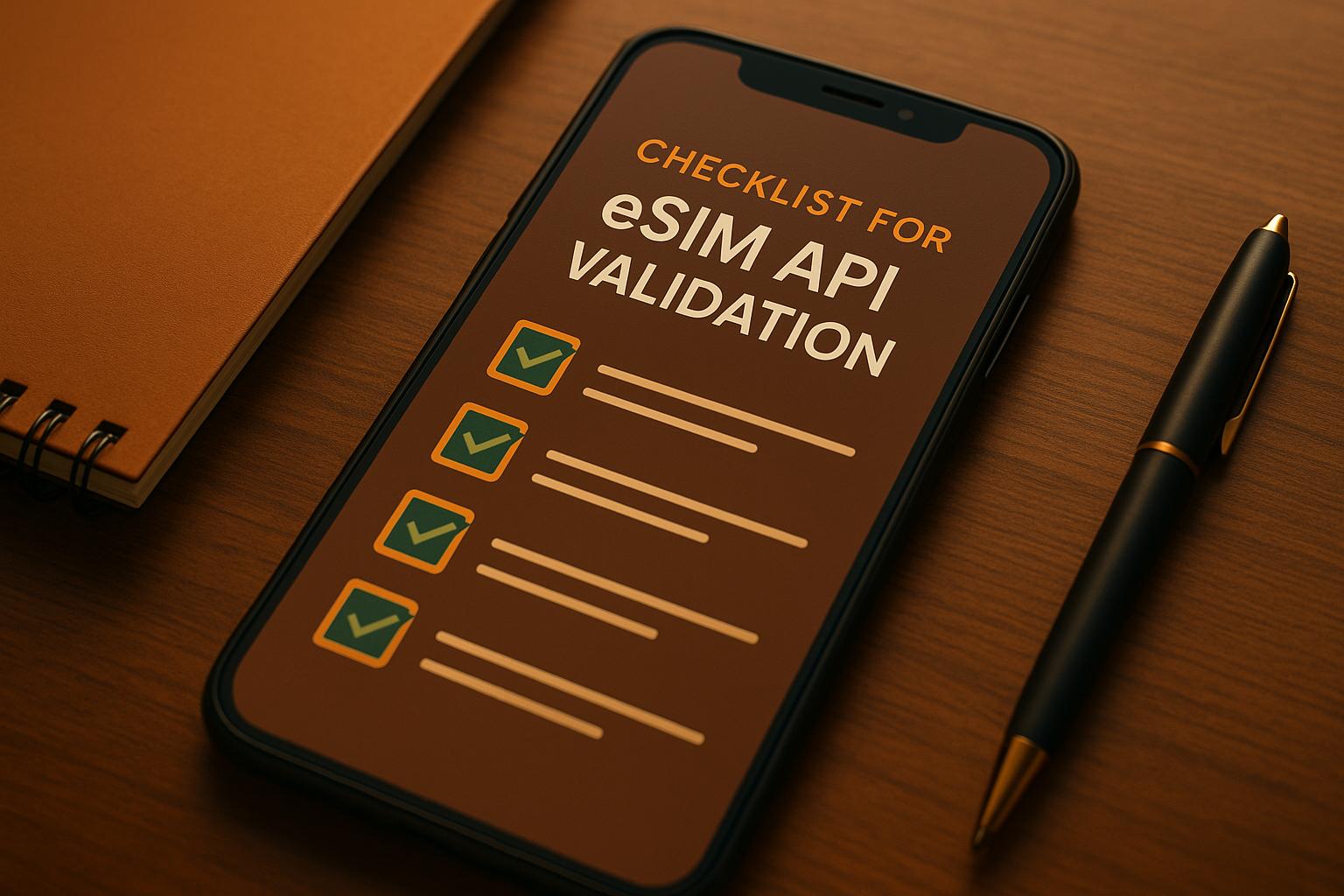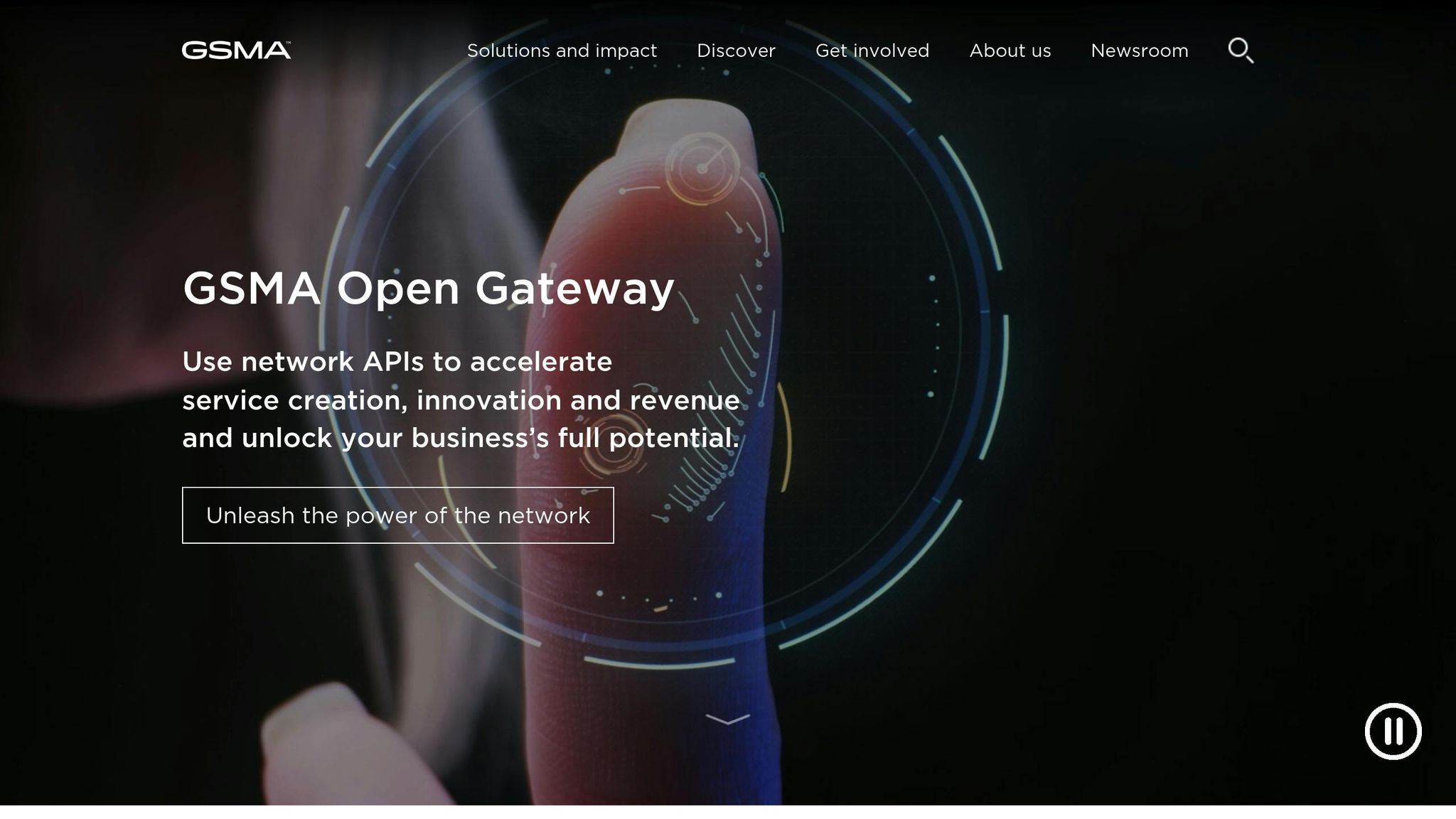Checklist for eSIM API Validation
https://www.zimconnections.com/checklist-for-esim-api-validation/
 SHARE
SHARE
eSIM APIs are critical for managing mobile network connections, facilitating tasks like profile downloads, authentication, and secure data handling. Proper validation ensures these APIs function reliably, meet industry standards, and remain secure against vulnerabilities. With the average cost of a data breach reaching £3.2 million in 2024, securing eSIM APIs is non-negotiable.
Here’s what you need to know:
- GSMA Standards: Follow specifications like SGP.21 (architecture), SGP.22 (remote provisioning), and SGP.23 (testing). IoT-specific guidelines (SGP.31–33) address unique requirements for connected devices.
- Security Protocols: Use end-to-end encryption, comply with GDPR, and implement multi-layered authentication. Regular audits and vulnerability assessments are vital.
- Testing: Validate API functionality through profile lifecycle tests (download, activation, switching), error handling, and performance under stress. Combine manual and automated testing for better coverage.
- Certification: Obtain GSMA certifications (e.g., PP-0084, SAS-UP) for compliance and security assurance.
- Documentation: Provide clear, detailed API guides with examples, error codes, and troubleshooting steps. Regular updates ensure alignment with evolving standards.
With the eSIM market projected to grow significantly by 2028, thorough validation is key to delivering secure, reliable, and compliant solutions. Whether you’re a network operator, device manufacturer, or eSIM reseller, this checklist helps you navigate the complexities of eSIM API implementation.
Getting Started with eSIM Access API in Less Than Two Minutes
eSIM API Standards and Compliance Requirements
Standards and compliance frameworks are the backbone of reliable eSIM API validation. They ensure seamless communication across networks while maintaining high levels of security. This section dives into the GSMA standards, certification processes, and security protocols that are essential for validation.
GSMA Specifications for eSIM APIs

The GSMA has established a set of guidelines that define how eSIM APIs should operate. These specifications are critical for ensuring compatibility and functionality across the eSIM ecosystem:
- SGP.21: This serves as the core architecture specification, detailing how different components within the eSIM ecosystem interact. It lays the foundation for technical implementations.
- SGP.22: Focuses on remote SIM provisioning, covering essential processes like profile downloads and device authentication.
- SGP.23: Defines test cases and procedures to ensure API implementations function correctly in various scenarios.
- SGP.31, SGP.32, and SGP.33: Address the specific needs of IoT eSIMs, particularly their power and connectivity constraints. With 2.2 billion cellular IoT connections expected to use licensed LPWAN by 2027 – up from 162 million in 2020 – these IoT-specific standards are becoming increasingly important.
Compliance with these specifications is overseen by SGP.24, which outlines how organisations should demonstrate adherence to the standards. Additionally, SGP.25 focuses on eUICC protection profiles, ensuring hardware-level security.
| Specification | Purpose | Focus |
|---|---|---|
| SGP.21 | eSIM Architecture Specification | System architecture and component interaction |
| SGP.22 | eSIM Technical Specification | Remote provisioning technical details |
| SGP.23 | eSIM Test Specification | Testing procedures and validation |
| SGP.31 | eSIM IoT Architecture | IoT-specific architectural requirements |
| SGP.32 | eSIM IoT Technical Specification | IoT device technical implementation |
| SGP.33 | eSIM IoT Test Specification | Testing for IoT eSIM implementations |
Certification Body Requirements
The GSMA has developed a comprehensive compliance framework to validate every component within the eSIM ecosystem. This framework goes beyond technical testing to ensure real-world security and reliability.
“The GSMA eSIM Compliance and Certification process were designed and introduced to serve and safeguard the eSIM ecosystem, of which they are an indispensable element. The GSMA strongly encourages the industry to recognise and invest in these security assurance initiatives to ensure the highest standards of quality, security, and interoperability.”
For eUICC compliance, three certifications are required:
- PP-0084 Common Criteria certificate: Focused on the IC chip.
- PP-0100 (or eSA Scheme) certificate: For the software.
- GSMA SAS-UP audit: Covers manufacturing standards.
GlobalPlatform functional certification is also mandatory for eUICCs. Consumer eUICCs must comply with SGP.23-1, while IoT eUICCs follow SGP.33-1. Additionally, SM-DP+ and SM-DS require certification under GSMA SAS-SM standards, ensuring that critical infrastructure components handling profile management and discovery services meet stringent security benchmarks.
Security and Privacy Standards
The security of eSIM APIs involves much more than basic encryption. The eUICC Security Assurance Scheme (outlined in SGP.06, SGP.07, SGP.08, and SGP.18) provides a comprehensive framework for security validation.
End-to-end encryption is mandatory throughout the communication chain. This includes the secure transmission of profile data, authentication tokens, device identifiers, and management commands. In multi-destination operations, encryption must be robust enough to meet varying regulatory requirements.
Data privacy compliance is equally critical. Adherence to international standards like GDPR is required, with mechanisms for user consent, data minimisation, and transparent control over personal information. By 2030, 98% of smartphone connections in North America are expected to rely on eSIM technology, highlighting the need for stringent privacy measures.
The authentication framework must support multiple verification methods, such as device-level authentication, user verification, and network operator validation. Every authentication step should be logged for audit purposes. Secure development practices, including adherence to secure coding standards, regular security audits, and vulnerability assessments, are also essential. Furthermore, sensitive operations – like profile installation and deletion – must be conducted exclusively through authenticated and encrypted channels.
API Environment Setup
Setting up an API environment for eSIM operations requires adherence to GSMA compliance and security standards. The environment should replicate real-world conditions to support live testing scenarios. Unlike the typical sandbox environments used in traditional API testing, eSIM API validation often occurs in live environments with real funds and active connections. This approach ensures accurate and reliable testing outcomes aligned with GSMA specifications.
API Access and Integration Requirements
To begin testing with the eSIM API, you’ll need to create an account and deposit the necessary funds. Once these steps are complete, you’ll receive an AccessCode, which acts as your primary API key. This code must be included in the RT-AccessCode header for all API requests. Keep in mind that the API enforces a rate limit of 8 requests per second to ensure stable and secure operations.
Authentication and Authorisation Setup
Strong authentication measures are essential for safeguarding API interactions. Start by using the AccessCode in the RT-AccessCode header for basic authentication. For added security, implement HMAC-SHA256 signature calculations with a secret key.
All data transmissions should occur over encrypted channels, such as HTTPS, to prevent data breaches. Additionally, sensitive operations must be encrypted. To maintain system security, set token expiration times, use refresh tokens for better user experience, and regularly rotate credentials. Once authentication is in place, you can proceed to configure the Remote SIM Provisioning platform for complete integration.
Remote SIM Provisioning Platform Configuration
The Remote SIM Provisioning (RSP) platform plays a key role in managing and distributing eSIM profiles. Configure the SM-DP+ integration to support both push and pull provisioning models, allowing profiles to be delivered either immediately upon connection or on demand.
Each eUICC (embedded Universal Integrated Circuit Card) has a unique EID that must be carefully tracked. Maintain up-to-date records of profile availability and ensure compatibility with devices. Proper management of these identities is critical for seamless operations.
Follow GSMA standards, such as SGP.02 for M2M applications, SGP.22 for consumer devices, and SGP.31/32 for IoT implementations, to cover a variety of use cases. Ensure the platform supports automated testing and smooth communication between system components through its API integration capabilities. Lastly, implement strong security protocols, including encryption and compliance with eUICC management standards, to meet certification requirements.
eSIM API Function Testing
Testing eSIM API functionality is crucial to ensure effective management of eSIM profiles under real-world conditions. Building on the API environment setup, this section outlines how to validate core features and implement robust error handling and backup strategies.
Core API Functions and Test Cases
The foundation of eSIM API testing lies in verifying profile lifecycle management. This includes testing profile download, installation, activation, switching, deletion, and managing multiple profiles on a single device.
- Profile download testing: Assess downloads under varying file sizes and network conditions. Ensure downloads resume seamlessly after interruptions.
- Installation and activation testing: Confirm that profiles install and activate correctly, even when dealing with limited storage or multiple profiles.
- Profile switching functionality: Validate smooth profile switching without interrupting ongoing services, including during active sessions.
Perform detailed CRUD testing on API endpoints. Check for correct status codes, accurate data formats, and complete payloads. Validate parameters to block invalid requests at the source, while response validation ensures data integrity across operations.
Additionally, test for security vulnerabilities like injection attacks and verify that the API enforces the 8 requests per second limit defined during setup.
Error Handling and Backup Systems
Strong error handling is key to building reliable eSIM APIs. Testing should simulate failures to ensure robust recovery mechanisms.
Chaos testing is an effective way to validate error-handling capabilities. As Prince Onyeanuna from API Development explains:
“Chaos testing is a technique that deliberately introduces failures into your API to see how well it recovers. Instead of assuming everything will work perfectly, you simulate real-world issues – like network disruptions, high latency, or harmful data – to ensure your API can handle them. The goal isn’t just to break things but to make your API more resilient.”
Simulate real-world scenarios such as network delays during profile downloads, server crashes during profile activation, or unexpected payloads that could corrupt data.
Error handling should include automatic retry mechanisms with exponential backoff to manage temporary failures. Circuit breakers should prevent cascading issues when downstream services fail, and error messages must provide meaningful information without revealing sensitive details.
For backup system testing, verify that failover procedures work seamlessly when primary systems go offline. Test profile recovery from backups, ensure data consistency after restoration, and confirm that users can continue operations during maintenance periods.
Implement advanced logging and monitoring tools (e.g., Loggly, Splunk, New Relic) to detect anomalies quickly when error rates exceed acceptable thresholds.
Manual and Automated Testing Methods
Once error handling is validated, test the API’s performance using a combination of manual and automated methods. The GSMA SGP.23 RSP Test Plan serves as a reliable framework for comprehensive test coverage.
Manual testing plays a critical role in eSIM API validation. It helps uncover edge cases that automated scripts might overlook and provides real-world insights into user experience. This is particularly useful for assessing device compatibility across manufacturers, testing user interface responses during profile switching, and identifying usability issues in API responses.
Focus manual testing on complex integration scenarios where human judgement is essential. For example, test profile installations on various devices, observe API behaviour under fluctuating network conditions, and evaluate user experience during profile switching.
Automated testing, on the other hand, ensures speed and broad regression coverage. Use it to run critical path tests continuously, especially for core profile management functions, while reserving manual testing for less frequent but intricate scenarios.
Carriers should conduct in-house quality assurance to ensure all features function as expected before updates are deployed to production. Early detection of integration issues helps maintain high service standards.
sbb-itb-273ea09
Automated Testing Tools and Methods
To maintain consistent quality in eSIM APIs, it’s crucial to adopt the right testing tools and frameworks. A well-chosen combination of tools, thorough test coverage, and seamless integration into your workflow ensures your API meets industry standards while cutting down on manual testing efforts. Below, we’ll explore essential tools and strategies to support effective automated testing.
Testing Tools and Frameworks
Choosing the right testing tools depends on your specific needs, such as functionality, ease of use, integration capabilities, and cost. Modern tools typically support protocols like REST, SOAP, and GraphQL, each excelling in different areas.
- Postman: Known for its user-friendly interface, Postman is perfect for eSIM API testing. It supports collaborative workflows and integrates smoothly with CI/CD pipelines, making it ideal for exploratory testing.
- SoapUI: This tool is highly effective for functional, security, and load testing, particularly in enterprise-level eSIM deployments. However, its advanced features come with a steeper learning curve.
- JMeter: An open-source solution designed for performance testing, JMeter is particularly useful for stress-testing eSIM APIs under heavy traffic. While powerful, its dated interface and complexity may require additional training.
- Katalon Studio: With support for web, API, mobile, and desktop applications, Katalon Studio offers low-code and AI-enabled testing features. Its versatility makes it a strong choice for teams working across multiple platforms.
- REST-assured: Tailored for Java-based environments, REST-assured simplifies REST API testing with native Java integration. However, it does require your team to have Java expertise.
Test Coverage Requirements
Effective testing requires covering all critical aspects of your API, including functionality, security, performance, and compliance. Here’s how to approach each area:
- Functionality Testing: Ensure your API delivers accurate outputs for given inputs, rejects invalid values, and handles empty or null inputs gracefully. This includes testing profile lifecycle management and device compatibility.
- Security Testing: Validate authentication across all endpoints, check for unhandled HTTP methods, and guard against parameter tampering. Continuous monitoring is key to identifying vulnerabilities.
- Performance Testing: Conduct load tests to measure API responsiveness, identify memory leaks, and assess profile download speeds – essential for real-time profile switching.
- Compliance Testing: Use automated checks to ensure GDPR and other regulatory requirements are met. Integrate these checks into your CI/CD pipeline for ongoing compliance.
- Interoperability Testing: Verify that eSIM profiles function seamlessly across various devices, operating systems, and network configurations by conducting beta trials.
Continuous Integration and Monitoring
Integrating automated tests into your CI/CD pipeline is essential for maintaining high API performance and security. Continuous monitoring provides real-time insights, helping identify and resolve issues before they impact users.
- Performance Benchmarks and Alerts: Set benchmarks for key metrics like profile download speeds, activation success rates, and network switching response times. Configure alerts to notify your team when these thresholds are exceeded.
- Monitoring Tools: Platforms like New Relic and Grafana offer real-time performance insights, helping to pinpoint bottlenecks and manage peak loads effectively.
- Post-Deployment Testing: Conduct smoke tests and regression tests after deployment to ensure APIs perform reliably in live environments, where network conditions and device compatibility can vary.
Automated testing minimises human error and ensures consistent test coverage, while continuous monitoring keeps your API performing at its best. Incorporating automated security tests into your CI/CD pipeline further strengthens your defences, ensuring every code change is rigorously checked for proper authentication, authorisation, and encryption. This combination of tools and strategies ensures your eSIM API remains reliable, secure, and high-performing.
Documentation and Issue Management
After rigorous API function testing and automated validations, the final steps in the validation process involve creating clear documentation and addressing issues promptly. These steps are critical to ensuring a reliable eSIM API. Without well-structured documentation, even the best API can become a challenge to implement. Similarly, ineffective issue management can escalate minor problems into major deployment hurdles. According to Smartbear‘s State of Software Quality (API) Report 2023, documentation is among the top four factors decision-makers evaluate when considering integration with a third-party API.
API Documentation Requirements
Building on the foundation of thorough testing, high-quality documentation is essential for smooth API integration. Effective eSIM API documentation should provide developers with all the information they need to implement the API successfully. This includes detailed endpoint information, such as available methods, resources, authentication protocols, parameters, and headers. These elements directly affect the developer experience, encourage API adoption, and reduce the volume of support requests.
A concise “get started” page is a must-have. This section should summarise key product details and provide an easy-to-navigate introduction, helping developers quickly determine if the API meets their needs.
| Element | Description |
|---|---|
| Overview | Explains the API’s purpose and target audience |
| Quick Start Guide | Offers a step-by-step walkthrough for basic operations |
| Authentication | Details how users can authenticate and access the API |
| Endpoints | Lists all available endpoints (URLs) for interacting with the API |
| Request and Response Examples | Provides examples of properly formatted API requests and expected responses |
| Error Codes and Handling | Describes potential error codes and their meanings |
| Rate Limiting | Explains restrictions on the number of API requests |
Examples are vital, especially for managing eSIM profiles. Developers benefit from detailed examples for tasks like profile downloads, activation processes, and handling errors. Providing code samples in multiple programming languages enhances accessibility and usability.
Interactive documentation can further improve the developer experience, allowing users to test endpoints directly within the interface. Additionally, consistency and clarity are non-negotiable. Use standardised terminology for eSIM-specific concepts like profile switching, device compatibility, and network provisioning. Regular updates are crucial to keep the documentation aligned with evolving eSIM technology standards.
Issue Tracking and Resolution Process
While documentation supports API integration, effective issue management ensures ongoing reliability. A well-defined workflow is vital for tracking issues from identification to resolution. For eSIM APIs, prioritising issues is especially critical – security vulnerabilities or profile activation failures must be addressed immediately.
Clear error messages play a key role in helping users diagnose and resolve problems quickly. Your issue tracking process should capture both technical details and the broader impact on user experience, such as device compatibility challenges, network switching errors, or profile corruption.
Maintaining a knowledge base of common issues and solutions can significantly speed up problem resolution. For eSIM APIs, this is particularly useful as recurring problems may surface due to specific device manufacturers, operating systems, or network configurations.
Change logs are another essential tool. They provide transparency by documenting resolved issues, explaining what was changed, why, and any potential effects on existing integrations. This level of detail is invaluable for compliance audits and helps prevent regression issues.
Establish feedback loops with API users to ensure fixes address real-world concerns effectively. Regular communication with developers can help identify emerging issues early, especially as new devices or carrier updates may introduce unforeseen compatibility problems.
Finally, assign clear ownership of documentation updates. This responsibility should include not just creating the initial documentation but also maintaining it, updating issue resolutions, and expanding the knowledge base over time. By integrating documentation updates into your development workflow, you ensure that changes in code are accurately reflected throughout the API’s lifecycle.
Conclusion
Thoroughly validating eSIM APIs is key to ensuring reliable global connectivity in today’s mobile-driven world. This detailed checklist is designed to help your eSIM implementation align with GSMA specifications, maintain strong security protocols, and deliver smooth user experiences across various devices and networks.
With the eSIM market growing rapidly, validation has never been more critical. By 2028, it’s estimated that half of all smartphones will support eSIM technology, while the Travel eSIM market is expected to grow by 500% between 2023 and 2028. Additionally, international business travel has rebounded to over 65% of pre-pandemic levels as of 2023, emphasising the demand for reliable, borderless connectivity solutions.
Each validation step plays a direct role in meeting the expectations of modern users, who value flexibility and reliability above all.
Practical implementation of these validation principles offers tangible benefits. For example, ZIM Connections showcases the impact of rigorous API validation. Trusted by over 100,000 travellers across 200+ destinations, their platform delivers features like AI-driven plan recommendations, multi-network connectivity, and instant activation. Their Business Suite further enhances usability with tools like centralised dashboards, real-time usage tracking, and the flexibility of contract-free scalability.
The financial stakes are equally high. API security breaches have affected 40% of organisations in the past year, with the average cost of such breaches reaching £4.8 million. Protecting your APIs is not just about safeguarding infrastructure – it’s about preserving your reputation. As Kevin McCarthy aptly puts it:
“That’s why erudite API security implementations that stem from experience, a strong grasp of the fundamentals, and smart partnerships remain such a critical cornerstone in building a safe organization”.
Whether you’re catering to global travellers in need of affordable connectivity or enterprises managing remote teams, this checklist provides the foundation for building secure, scalable, and reliable eSIM APIs. It’s a roadmap to meeting the demands of an increasingly interconnected world.
FAQs
What are the main GSMA standards for eSIM APIs, and why are they essential for compatibility and security?
The GSMA standards for eSIM APIs, like SGP.22 v3.0 and SGP.32, define the structure for eSIM architecture, remote provisioning, and management protocols. These guidelines create a consistent method for data transfer and device authentication, enabling smooth interaction between devices and networks.
Following these standards is essential for safeguarding security and mitigating risks in eSIM management. They also help ensure that eSIM technology stays dependable and ready to meet changing demands over time.
How does validating eSIM APIs protect data and ensure compliance with industry standards?
Validating eSIM APIs plays a key role in protecting data and ensuring compliance with industry regulations. It secures remote provisioning protocols, ensuring that only authorised profiles can be installed. By using strong encryption methods like AES and RSA, sensitive information stays safeguarded from unauthorised access.
Moreover, the validation process ensures alignment with GSMA specifications, which outline rigorous security standards and certification procedures. This helps build a trusted and standardised framework, reducing the risk of data breaches and supporting regulatory compliance.
What tools and methods are recommended for validating eSIM API functionality and ensuring security?
To test the functionality of eSIM APIs, tools like Postman, REST-assured, Katalon Studio, SoapUI, Apigee, and JMeter are incredibly useful. These tools simplify the process of pinpointing issues and confirming the reliability and performance of the APIs.
When it comes to security validation, tools such as eSIM Profile Generators and mobile testing solutions from reputable providers play a critical role. Using hardware security modules (HSMs) and following stringent security protocols helps safeguard profile management and protects sensitive data throughout the process.
By leveraging these tools and adhering to these practices, you can ensure your eSIM APIs function reliably and securely, aligning with industry standards and delivering smooth performance.









































































































































































































